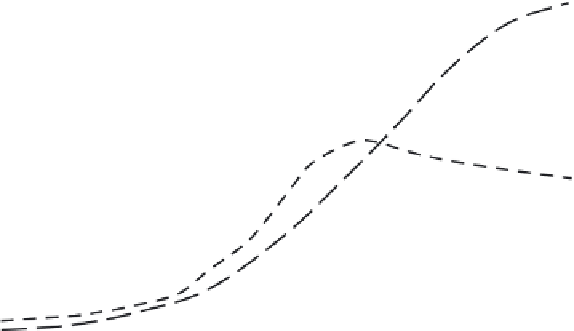Environmental Engineering Reference
In-Depth Information
E
D
C
A
B
1950
+
Year
FIGURE 1.13
Speculative chart on status of global population relative to conservation of the nonrenewable natural resources.
A is the status of population based on current usage of resources, B is the speculative quantity of nonrenewable
resources remaining available, C is the status of population based on conservation of resources, use of 4Rs, and
alternative materials and energy sources, D is the available nonrenewable natural resources using conservation
management and 4Rs, E is the assumed availability of alternative materials and energy sources.
Assuming that conservation measures for nonrenewable geoenvironmental natural
resources are in place and that these measures are bolstered by the use of the 4Rs (reduc-
tion, reuse, recycle, and recovery), we can further reduce the depletion rate of the nonre-
newable resources using alternative energy sources such as geothermal, wind, solar, etc.
The curve C shown in Figure 1.13 indicates the status of the global population based on
conservation of the nonrenewable resources, use of 4Rs and use of alternative materials
and energy sources, D is the available natural geoenvironmental resources using conser-
vation management, 4Rs, and alternative energy sources. Finally, curve E shown in Figure
1.13 is an assumption of the resources that would be made available using alternative
materials and various other alternative energy sources.
1.5.2 4Rs and Beyond
Although not strictly within the purview of geoenvironmental sustainability consider-
ations, the implementation of 4Rs as a means to protect the geoenvironment and also to
aid in reduction of nonrenewable resource depletion deserves special attention. Details of
many aspects of these will be discussed in subsequent chapters.
By itself, the common understanding of the 4Rs is recovery, reuse, recycle, and reduc-
tion. Application of the 4Rs to waste products can reduce the depletion rate of many non-
renewable geoenvironmental resources. A good case in point is the use of coal ly ash as a
backill and liner material. Figure 1.14 shows some of the beneits—as they pertain to the
geoenvironment and to the reduction in use of natural geo-materials (Horiuchi et al., 2000;
Yamagihara et al., 2000). Traditional disposal of the coal ly ash on land or in the ocean is
not an acceptable solution. Reuse of the material not only satisies the aims of the 4Rs but





Search WWH ::

Custom Search